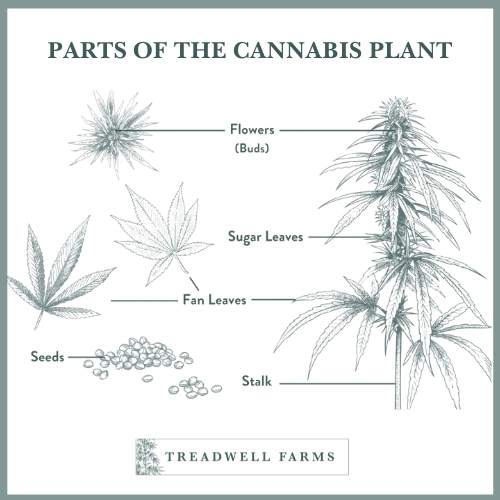Parts of the Cannabis Plant

AUTHORED BY: GENESTER WILSON-KING, MD FACOG & SARAH RUSSO
Parts of the Cannabis Plant: Unique Attributes and Uses Abound
When people talk about cannabis they are generally referring to the flowers (buds) of Cannabis spp. These special buds get a lot of the publicity, and rightfully so. But what about other parts of the plant? The leaves, stalks, seeds, roots of cannabis have their own unique properties and offer the potential of botanical synergy. Let’s break them down here, piece by piece. For a nice overview of the parts of the plant and their unique uses, check out the chart at the bottom of the article.
FlowersNugs. Buds. This is where the fame of cannabis resides. When people smoke cannabis or make plant medicine, they use the flowers. The growing number of studies on the medicinal attributes of the plant have revolved around cannabinoids, which are housed in the trichomes of cannabis buds. That’s also where terpenes are found in the highest concentration. Resin, the sticky collection of trichomes, has historically been used to make hash, kief, and other cannabis concentrates for centuries.
When found in its natural state growing on the plant, “raw” cannabinoids are in their acidic form (ex THC-A, CBDA). When heat is applied, that’s when cannabinoids are transformed into their neutral form. That’s how we imbibe CBD, THC and other cannabinoids. [1] Since we are only beginning to scratch the surface of the potential of cannabinoid medicine, terpenes, and other components, more investigation is needed not only on cannabis flowers, but on other parts of the plant as well.
LeavesSurrounding the buds of the plant grow the iconic “pot” leaves. The leaves protect the plant from the elements, pests, and other factors. [1] The sugar leaves (those growing closest to the flowers) contain more trichomes (“crystals”) than the fan leaves, but nowhere near as much as cannabis flowers themselves. [2] The excess sugar leaves trimmed away during the manicuring of the buds (known as “trim”) can be used in cooking or tincture making.
Cannabis leaves have a long history of use in Jamaica, where women historically were responsible for providing cannabis leaf tea to the whole family. Cannabis tonics are consumed in Jamaica by people of all ages, genders, and economic status to maintain good health. [3] Cannabis leaves contain a compound known as canniprene, a potentially interesting anti-inflammatory agent. [4]
Juicing cannabis leaves has become more popular in recent years. Many people attribute the benefits of juicing to the presence of acidic cannabinoids (like THCA, CBDA) in the plant. However, while cannabis leaves are rich in chlorophyll, they actually have a very low acidic cannabinoid content. For those seeking acidic cannabinoids, the best bet is to go with using cannabis buds (flowers). However, some acidic cannabinoids like CBDA may be quite potent at low doses. [1] Chlorophyll is one of the components of green juice. Fan leaves are packed with that and phytonutrients. Fan leaves can be made into juice, infusions, or in topical preparations. [5,6] More research needs to be done on cannabis leaves to differentiate their unique composition and learn more about their therapeutic potential.
SeedsWhen speaking of superfoods, cannabis seeds fit the bill. They may be one of the most nutritionally complete foods available, and have been consumed in China for at least 3,000 years. [7] They contain 35% protein and all essential amino acids. They also have potent antiinflammatory properties. They are rich in essential fatty acids in a 3:1 ratio which is considered to be an ideal nutritional target. [1]
Cannabis or hemp seeds have an outer hull and inner “heart”. Both whole and peeled options are available on the market. The hull itself has been investigated for its antioxidant activity and potential anti-cancer properties. [1] In order to reap the full medicinal potential of cannabis seeds, keep it on the crunchy side! Cannabis seeds also make nutrient-rich animal feed, a concept that has been backed up both in feeding trials and observational data collected over thousands of years. [7]
RootsDespite an extensive history of medicinal use, cannabis roots haven’t received much attention in present day medical practice and research. Roots of cannabis have been used for centuries to treat conditions such as fever, inflammation, burns, tumors, infection, and gastrointestinal issues. Traditional methods included pounding the fresh root to extract their juice. Topical applications and water extraction were popular methods of preparation. Cannabis roots were also mixed with fats like oil or butter and even infused in wine. [8]
Cannabis roots contain no cannabinoids, but are rich in compounds like friedelin and epifriedelanol. Friedelin is the most prominent triterpenoid in cannabis. Epifriedelanol is a related triterpenoid that may possess anti aging properties. [1] Modern research has examined the compounds found in cannabis roots for pain, inflammation, and fever. It has also been studied for its antimicrobial activity. The source of cannabis roots must be carefully considered if they are being used for medicine, as the cannabis plant accumulates heavy metals from the soil. Future studies on cannabis roots will help to determine the best preparation methods and which conditions they may best serve. [8]
Stalk and StemsGenerally discarded by growers cultivating cannabis for flower production, the stalks of cannabis provide their own unique contribution to humankind. Cannabis stalks provide us seemingly limitless possibilities for fabrics, clothing, paper, housing, and much more. The strong stalk is where building materials are made that can act as a substitute for cement, fiberglass, insulation, and others. [9]
Cannabis stalk (fiber) is known for its incredible strength and durability, being twice as strong as wood. The stalks are also incredibly rot resistant and its fiber is biodegradable, unlike plastics and many other materials we depend on daily. [10] Another solid use for Cannabis/hemp stalks is as garden mulch. Stalks are naturally insect resistant, so having it surrounding the soil in the garden can help keep pests at bay. [11] Stalks can also be used for animal bedding, providing a less dusty alternative to straw which benefits the lung health of the animals. And cannabis stalks have a higher absorbency than straw, which leaves barns in need of less frequent cleanings. [12,13]
Some people use discarded stems separated from flower buds for steeping tea or extracting cannabinoids. The stems are very low in cannabinoids and will likely not yield much to note a change in effect. [1] Until more research is conducted, it might be best to keep stems and stalks for what they do best, creating top notch fibrous materials.
Conclusion
If the grand landscape of cannabis discovery has taught us anything, it is that the plant cannot be distilled down to one mere part (the buds) or target compound (CBD, THC, etc). Every part of this plant can be used for nutrition, healing to the body, and/or benefit the environment. How amazing is that? And much more research needs to be done on the plant in its entirety in order to uncover more of its vast healing potential.
Some of the plethora of uses of the plant are outlined below:

Clarke, R. C., & Merlin, M. D. (2016). Cannabis domestication, breeding history, present-day genetic diversity, and future prospects. Critical reviews in plant sciences, 35(5-6), 293-327. (reused with permission by the authors)
Sources
- Russo, E. B., & Marcu, J. (2017). Cannabis pharmacology: the usual suspects and a few promising leads. In Advances in pharmacology (Vol. 80, pp. 67-134). Academic Press.
- Parsons, J. L., Martin, S. L., James, T., Golenia, G., Boudko, E. A., & Hepworth, S. R. (2019). Polyploidization for the genetic improvement of Cannabis sativa. Frontiers in plant science, 10, 476.
- Dreher, M. C., Nugent, K., & Hudgins, R. (1994). Prenatal marijuana exposure and neonatal outcomes in Jamaica: an ethnographic study. Pediatrics, 93(2), 254-260.
- Allegrone, G., Pollastro, F., Magagnini, G., Taglialatela-Scafati, O., Seegers, J., Koeberle, A., ... & Appendino, G. (2017). The bibenzyl canniprene inhibits the production of pro-inflammatory eicosanoids and selectively accumulates in some Cannabis sativa strains. Journal of Natural Products, 80(3), 731-734.
- Zambeza. (2019). Cannabis Fan Leaves & 5 Great Ways To Use Them. Accessed on October 1, 2020.
- Campbell, L. G., Naraine, S. G., & Dusfresne, J. (2019). Phenotypic plasticity influences the success of clonal propagation in industrial pharmaceutical Cannabis sativa. PloS one, 14(3), e0213434.
- Padua, L. S., & Bunyapraphatsara, N. (1999). Plant Resources of South-East Asia (Medicinal and Poisonous Plants 1): Simaroubaceae. Netherlands: Buckhuys publishers. hlm, 272-275.
- Callaway, J. C. (2004). Hempseed as a nutritional resource: An overview. Euphytica, 140(1-2), 65-72.
- Ryz, N. R., Remillard, D. J., & Russo, E. B. (2017). Cannabis roots: a traditional therapy with future potential for treating inflammation and pain. Cannabis and cannabinoid research, 2(1), 210-216.
- Johnson, R. (2018). Hemp as an agricultural commodity. Library of Congress Washington DC Congressional Research Service.
- Garton, Kathy. (2017). “Why Hemp Mulch is Better for Vegetable Gardens”. The Marijuana Times. Accessed on 9/21/2020.
- Kane, Mari. "Four Basic Uses”. Pennsylvania Hemp Industry Council. Accessed on 9/21/2020.
- Threlkeld, Leslie. (2018). “Let's Talk About Hemp. And No, It's Not What You Think” Noelle Floyd. Accessed on 9/21/2020.
 Genester Wilson-King, MD FACOG is a Board-Certified Obstetrician and gynecologist with over 25 years of clinical experience providing compassionate and research-driven care to patients. After years of working as a full-service OB/GYN, she founded Victory Rejuvenation Center (VRC), a private holistic and preventive medicine practice that provides life-transforming management modalities and customized medicines to patients. She is the Medical Advisor to Treadwell Farms.
Genester Wilson-King, MD FACOG is a Board-Certified Obstetrician and gynecologist with over 25 years of clinical experience providing compassionate and research-driven care to patients. After years of working as a full-service OB/GYN, she founded Victory Rejuvenation Center (VRC), a private holistic and preventive medicine practice that provides life-transforming management modalities and customized medicines to patients. She is the Medical Advisor to Treadwell Farms.
As the Medical Director of VRC, Dr. Wilson-King provides services that help her patients age gracefully and achieve holistic well-being. She focuses on plant-based medicine, integrated health, nutrition, supplements, cannabis education, and hormone balance.
Dr. Wilson-King is Co-Vice President of the Society of Cannabis Clinicians (SCC). The SCC is an educational and scientific society of physicians and other professionals dedicated to the promotion, protection and support of cannabis for medical use. Dr. Wilson-King co-authored the Best Practices Guidelines for Cannabis Use in Pregnancy and Breastfeeding, and Cannabis Use in Women – Special Considerations (in progress). She is also on the Board of the Doctors For Cannabis Regulation (DFCR), the first and only national physicians’ association dedicated to the legalization and regulation of cannabis for adults. Advancing the DFCR’s commitment to addressing the disproportionate criminalization of cannabis use among communities of color and the nation’s poor, she regularly provides expert opinions for legal cases involving cannabis.
Dr. Wilson-King is a nationally recognized advocate, clinician, and educator for cannabis and hormone and wellness therapies. She presents on cannabis use in obstetrics and gynecology, hormone therapy for PMS, various stages of menopause, and for applications in nutrition.

Sarah Russo is a longtime plant enthusiast and globetrotter. She got her degree in environmental studies and social justice, with a focus on plant medicine from the Evergreen State College. She is a freelance writer, consultant, and project manager with over 13 years of experience in the cannabis and herbal medicine space. Her main objectives are fighting for the right to use plants, implementing social justice approaches in the cannabis industry, as well as encouraging sustainable agricultural practices. She is currently based on an island in the Mediterranean. Sarah is a content creator for Treadwell Farms.






